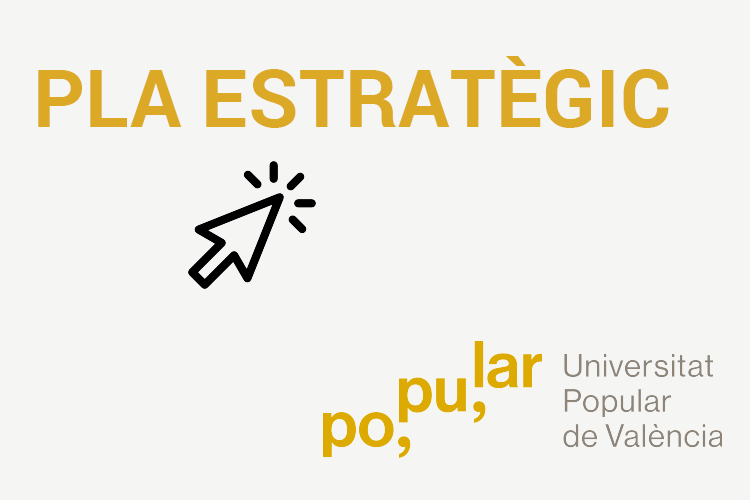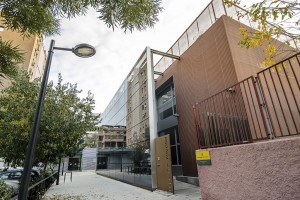 Do you want to catch a glimpse of the amazing London Town? Well, then, the English activity from #UPBenimamet invites you through these links not only to catch a simple glimpse but to show you the whole city. Why don’t you dare to travel while staying at home?
Do you want to catch a glimpse of the amazing London Town? Well, then, the English activity from #UPBenimamet invites you through these links not only to catch a simple glimpse but to show you the whole city. Why don’t you dare to travel while staying at home?
Vols donar-li una ullada a la sorprenent ciutat de Londres? Bé, doncs, l’activitat d’anglés de la #UPBenimàmet et convida a través d’aquests links no sols a donar-li una ullada sinó a ensenyar-te tota la ciutat al complet. Per què no t’atreveixes a viatjar mentre et quedes a casa?
Una proposta de #UPBenimàmet per a practicar anglés i realitzar al mateix temps diferents visites culturals a Londres en les que podran visualitzar diferents llocs emblemàtiques de l capital del Regne Unit.
L’activitat porta per títol STAY AT HOME AND VISIT LONDON i consisteix a convidar a les persones participants a quedar-se a casa i visitar #DesdeCasa virtualment alguns dels llocs més emblemàtics de la capital de Regne Unit en diferents entrregues que s’aniran actualitzant.
Segueix els vídeos [Indicacions i objectius al final]:
CAP. 1 A Grand Tour around London.
London Vacation Travel Guide: https://youtu.be/
LONDON-CITY TOUR 2017 / LET’S TRAVEL: https://youtu.be/bAgkeogi_
CAP. 2 Two Magnificent Religious Buildings
Would you like to know two of the most magnificent religious buildings in London City? Well, just stay at home and relax. The #English activity from #UPBenimamet invites you through these links to watch these two videos about Westminster Abbey and Saint Paul’s Cathedral Enjoy them!
T’agradaria conèixer dos dels més magnífics edificis religiosos de Londres? ? Bé, doncs, l’activitat d’anglés de la #UPBenimamet et convida a través d’aquests links a veure aquests dos vídeos sobre l’Abadia de Westminster i la Catedral de San Pau. Que els gaudeixes!
INSIDE WESTMINSTER ABBEY TOUR & REVIEW : https://youtu.be/s0C0syR9Mog
SAINT PAUL CATHEDRAL, LONDON : https://youtu.be/1eTv9pYVzMY
Cap. 3 LONDON MUSEUMS
Now that the Easter holydays are over, we are going to continue visiting our beloved London.The #English teacher, Jose Lozano, from #UPBENIMAMET invites you to relax and visit virtually four of the most important London museums without leaving home: British Museum, Tate Britain Museum, National Gallery and Science Museum. So, #StayAtHomeAndVisitLondon !!!
Ara que les vacances de de Pasqua han acabat, continuarem visitant nostra volguda Londres.El formador de #Inglés, José Lozano, de la #*UPBENIMAMET vos convida a relaxar-se i visitar virtualment quatre dels museus londinencs mes importants sense eixir de casa: British Museum, Tate Britain Museum, National Gallery i Science *Museum. Així que, #*StayAtHomeAndVisitLondon !!!
BRITISH MUSEUM
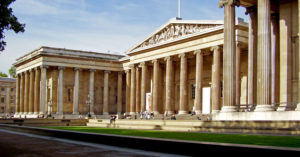
The British Museum’s outstanding collection spans over two million years of human history and culture. Over 6 million visitors every year enjoy its collection, including world-famous objects such as the Rosetta Stone, the Parthenon sculptures, and Egyptian mummies.
L’extraordinària col·lecció de The British Museum abasta al voltant de dos milions d’anys de la història i cultura de la humanitat. Més de 6 milions de visitants gaudeixen cada any de la seua col·lecció, que inclouen objectes mundialment famosos com la pedra *Rosetta, Les escultures del *Parthenon, i les mòmies egípcies.
Visit the museum through this link: / Visita el museo a través de este link:/ Visita el museu a través d’aquest link:
https://www.britishmuseum.org/
TATE BRITAIN MUSEUM
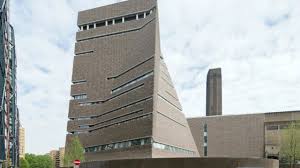
Tate Britain (known from 1897 to 1932 as the National Gallery of British Art and from 1932 to 2000 as the Tate Gallery) is an art museum on Millbank in the City of Westminster in London. It is part of the Tate network of galleries in England, with Tate Modern, Tate Liverpool and Tate St Ives. It is the oldest gallery in the network, having opened in 1897. It houses a substantial collection of the art of the United Kingdom since Tudor times, and in particular has large holdings of the works of J. M. W. Turner, who bequeathed all his own collection to the nation. It is one of the largest museums in the UK.
Tate Britain (coneguda des de 1897 fins a 1932 com la National Gallery of British Art i des de 1932 fins a l’any 2000 com la Tate Gallery) és un museu d’art en *Millbank a la ciutat de Westminster a Londres. Forma part de la xarxa de Galeries Tate a Anglaterra, juntament amb Tate Modern, Tate Liverpool i Tate St. Ives. És la galeria mes antiga de la xarxa, havent-se obert en 1897. Alberga una col·lecció important d’art del Regne Unit des de l’època Tudor, i en particular és propietària d’una àmplia quantitat de treballs del pintor J.M. Turner, que van ser llegades per ell a la nació. Es tracta d’un dels museus mes grans del Regne Unit.
Visit the museum through this link: / Visita el museo a través de este link:/ Visita el museu a través d’aquest link:
https://www.tate.org.uk/visit/tate-britain
NATIONAL GALLERY
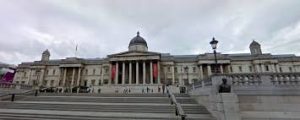
The National Gallery Collection contains over 2,300 very famous art works, such as van Eyck’s ‘Arnolfini Portrait’, Velázquez’s ‘Rokeby Venus’, Turner’s ‘Fighting Temeraire’ and Van Gogh’s ‘Sunflowers’.
All major traditions of Western European painting are represented in its collection from the artists of Middle Age and Renaissance Italy to the French Impressionists.
– 13th- to 15th-century paintings: Duccio, Uccello, van Eyck, Lippi, Mantegna, Botticelli, Dürer, Memling, Bellini
– 16th-century paintings: Leonardo, Cranach, Michelangelo, Raphael, Holbein, Bruegel, Bronzino, Titian, Veronese
– 17th-century paintings: Caravaggio, Rubens, Poussin, Van Dyck, Velázquez, Claude, Rembrandt, Cuyp, Vermeer
– 18th- to early 20th-century paintings: Canaletto, Goya, Turner, Constable, Ingres, Degas, Cézanne, Monet, Van Gogh
La col·lecció de la National Gallery conté mes de 2.300 obres artístiques molt famoses, com per exemple ‘El retrat Arnolfini de Eycks , `La Venus de l’espill´ de Velázquez, ‘Fighting Temeraire’ de Turner o ‘Els Gira-sols’ de Van Gogh. Les principals tendències pictòriques d’Europa Occidental estan representades en la seua col·lecció des dels artistes de l’Edat mitjana i del Renaixement Italià fins als impressionistes francesos. Inclou obres dels segles XIII al XV de Duccio, Uccello, van Eyck, Lippi, Mantegna, Botticelli, Dürer, Memling, Bellini; així com obres del segle XVI de Leonardo, Cranach, Michelangelo, Raphael, Holbein, Bruegel, Bronzino, Titian, Veronese. Del segle XVII es poden apreciar obres de Caravaggio, Rubens, Poussin, Van Dyck, Velázquez, Claude, Rembrandt, Cuyp, Vermeer; per a finalitzar amb obres pictòriques del segle 18 al 20 d’autors tan famosos com Canaletto, Goya, Turner, Constable, *ngres, Degas, Cézanne, Monet, Van Gogh
Visit the museum through this link: / Visita el museo a través de este link:/ Visita el museu a través d’aquest link:
https://www.nationalgallery.org.uk/
SCIENCE MUSEUM
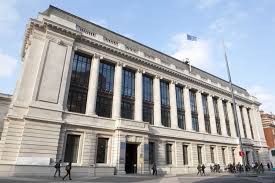
Striving to be the best place in the world for people to enjoy science, the Science Museum’s collection forms an enduring record of scientific, technological and medical achievements from across the globe. It aims to inspire visitors with award-winning exhibitions, iconic objects and stories of incredible scientific achievement.
Intentant ser el millor lloc del món per a la gent que gaudeix de la ciència, la col·lecció del Science Museum configura un registre durador dels avanços científics, tecnològics i mèdics de tot el globus. Intenta inspirar als seus visitants amb exhibicions guanyadores de premis, objectes icònics i històries d’increïble abast científic.
Visit the museum through this link: / Visita el museo a través de este link:/ Visita el museu a través d’aquest link:
https://www.sciencemuseum.org.uk/home
Cap. 4
THE WESTMINSTER PALACE ( Houses of Parliament) and the Big Ben.
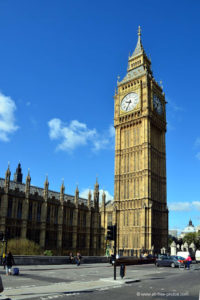
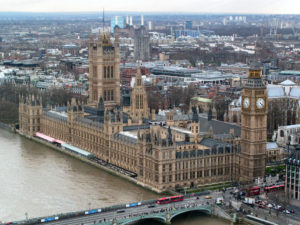
And now, What about visiting one of the most emblematic places in London?
One of the most visited surroundings in the city?
The Westminster Palace, better known as the Houses of Parliament. Its name derives from the neighboring Westminster Abbey and it serves as the meeting place for both the House of Commons and the House of Lords, the two houses of the Parliament of the United Kingdom.
The Palace, which lies on the north bank of the River Thames in the City of Westminster in central London, makes reference to either of its two original structures: the Old Palace, a medieval building-complex destroyed by fire in 1834, or its replacement, the New Palace that stands today; and it is owned by the monarch in right of the Crown and, for ceremonial purposes, retains its original status as a royal residence
The #English activity of #UPBenimàmet invites you all to visit its outside surroundings and its inside secrets through these two videos and links:
-
Charles Barry and A.W.N. Pugin, Palace of Westminster (Houses of Parliament): https://www.youtube.com/watch?v=7oBUIo5R5qg&t=20s
2. Inside The Houses of Parliament: https://www.youtube.com/watch?v=tYn-ma_AwkI&t=48s
3. Take a tour of the House of Lords : https://www.youtube.com/watch?v=_sLZBWcPklk
- Palace of Westminster in Night – HD: https://www.youtube.com/watch?v=GC3XkInHBXE
But Westminster palace is not only famous because it houses the British Parliament but also the most famous attraction in the city: the Clock Tower, known as Big Ben. This is the nickname for the Great Bell of the striking clock and it is usually extended to refer to both the clock and the clock tower. But the official name of the tower in which Big Ben is located, originally the Clock Tower, was renamed as Elizabeth Tower in 2012 to mark the Diamond Jubilee of Elizabeth II.
Big Ben is the largest of the tower’s five bells and weighs 13.5 long tons . It was the largest bell in the United Kingdom for 23 years. The origin of the bell’s nickname is open to question; it may be named after Sir Benjamin Hall, who oversaw its installation, or heavyweight boxing champion Benjamin Caunt.
Four quarter bells chime at 15, 30 and 45 minutes past the hour and just before Big Ben tolls on the hour. The clock uses its original Victorian mechanism, but an electric motor can be used as a backup.
Let’s know more about the tower, its clock and its functioning mechanism through these two video Links:
-
Big Ben History: https://www.youtube.com/watch?v=TyXrHfz9lAY
-
The Mechanical Genius of Big Ben | Blowing Up History: https://www.youtube.com/watch?v=_Elffjsjbio
EN VALENCIÀ:
THE WESTMINSTER PALACE ( Houses of Parliament) and the Big Ben.
I ara, què tal si visitem un dels llocs més emblemàtics de Londres? Un dels voltants més visitats de la ciutat?
El palau de Westminster, millorment conegut com la Casa del Parlament.
El seu nom deriva de la veïna Abadia de Westminster i serveix com el lloc de trobada de totes dues cambres parlamentàries, la cambra dels comuns i la cambra dels Lords, les dues cambres que componen el parlament del Regne Unit.
El palau, que es troba en el costat nord del riu Tàmesi a la ciutat de Westminster al Londres central, fa referència totes dues de les seues estructures originals: el vell palau, un complex medieval destruït pel gran incendi de 1884, i el seu reemplaçament, el nou palau tal com es troba hui; és propietat del monarca que sustenta la corona i, per a propòsits cerimonials, manté el seu estatus com a residència real.
L’activitat de #Inglés de #*UPBBenimàmet us convida a tots a visites tant el seu exterior com els seus secrets interiors a través d’aquests dos vídeo links:
- Charles Barry and A.W.N. Pugin, Palace of Westminster (Houses of Parliament): https://www.youtube.com/watch?v=7oBUIo5R5qg&t=20s
- Inside The Houses of Parliament: https://www.youtube.com/watch?v=tYn-ma_AwkI&t=48s
- Take a tour of the House of Lords : https://www.youtube.com/watch?v=_sLZBWcPklk
- Palace of Westminster in Night – HD: https://www.youtube.com/watch?v=GC3XkInHBXE
Però el Palau de Westminster no és només famós perquè alberga al Parlament Britànic sinó també al mes famosa icona de la ciutat: La Torre del rellotge, coneguda com Big Ben. Aquest sobrenom es deu a la gran campana que marca les hores del rellotge, i habitualment s’utilitza per extensió també per a referir-se tant al rellotge com a la torre. Però el nom oficial de la torre en la qual es troba la campana, anomenada originalment la Torre del Rellotge, va ser canviada de nom com la Torre Elizabeth en 2012 per a commemorar el `Diamond jubilee´ d’Elizabeth II, R.
El Big Ben és la campana més gran de la torre i pesa 13,5 tones. Va ser la campana més gran del Regne Unit durant 23 anys. L’origen del sobrenom fins i tot és una qüestió oberta: pot referir-se a Sir Benjamin Hall, que va supervisar la seua instal·lació. O bé al campió dels pesos pesants de boxa Benjamin Caunt.
La campana sona per a marcar els quatre quarts de l’hora i a més de l’hora en punt. El rellotge utilitza el seu mecanisme victorià original, però un motor elèctric es pot utilitzar com a suplement.
Coneguem mes sobre la torre, el rellotge i el seu mecanisme de funcionament: a través d’aquests dos links:
-
Big Ben History: https://www.youtube.com/watch?v=TyXrHfz9lAY
-
The Mechanical Genius of Big Ben | Blowing Up History: https://www.youtube.com/watch?v=_Elffjsjbio
CHAPTER 5. Buckingham Palace and other London’s Royal residences.
Now, in this fifth chapter, José Lozano, the teacher of #English at the #UPBenimàmet leads you into Royalty and our next step will be visiting the palace of Buckingham and other Royal London residences.
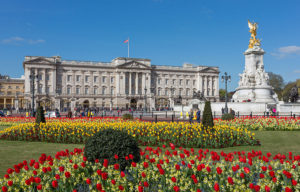 Buckingham Palace is the most important London residence of the monarchy of the United Kingdom, and it is not only considered as its administrative headquarters, but also as the centre of state occasions and royal hospitality, and a focal point for the British people at times of national rejoicing and mourning.
Buckingham Palace is the most important London residence of the monarchy of the United Kingdom, and it is not only considered as its administrative headquarters, but also as the centre of state occasions and royal hospitality, and a focal point for the British people at times of national rejoicing and mourning.
The land on which Buckingham Palace sits, in the borough of London known as Westminster, has been in the hands of the British monarchy for more than 400 years. It seems that King James I liked the site, and acquired it for use as a sort of garden for the royals. It also had a small, 4-acre grove of mulberry trees, which King James hoped to use for silk production (silkworms feed only on mulberry trees). At that time, there was a house on the property, and it passed through a succession of owners until 1698, when it was sold to John Sheffield, who later became the duke of Buckingham; and that is why the building was originally known as Buckingham House. Sheffield, finding the original house on the property outdated, decided to build a new residence on the site in the early 1700s., which can be considered as the building core of today’s palace.
Later on, this large house was acquired by King George III in 1761. He renovated its structure as a private residence for his wife Queen Charlotte and their children. And, after his family moved in, the building became known as the “Queen’s House.”
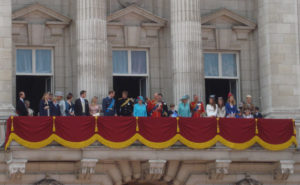 In 1802 His son George IV , who had grown up in Buckingham House, favored the building and made it the official royal residence. He hired the architects John Nash and Edward Blore to enlarge and renovate the building structure and they constructed three more wings around a central courtyard. But, when George IV died and his brother William IV, ascended to the throne in 1830, he had no interest in relocating to the newly built Buckingham Palace and preferred his princely home, Clarence Palace, instead.
In 1802 His son George IV , who had grown up in Buckingham House, favored the building and made it the official royal residence. He hired the architects John Nash and Edward Blore to enlarge and renovate the building structure and they constructed three more wings around a central courtyard. But, when George IV died and his brother William IV, ascended to the throne in 1830, he had no interest in relocating to the newly built Buckingham Palace and preferred his princely home, Clarence Palace, instead.
In 1833-34, the British Parliament voted to complete the furnishing and interior refurbishment of Buckingham Palace for use as the official royal home. Following William IV’s death, in 1837, his niece, Victoria, assumed the throne and Buckingham Palace became the London residence of the British monarchs until today. Its Construction was completed in 1853, and Queen Victoria reigned and lived here until her death in 1901. Her son Edward VII ascended to the throne, and he is credited with an interior redesign of the palace, the remnants of which can still be seen today.
The last major structural additions were made during the late 19th and 20th centuries; including the East Front, which contains the well-known balcony on which the royal family traditionally congregates to greet crowds. Since Queen Victoria’s first appearance, standing on Buckingham’s balcony has become something of a tradition for royal events. In 2002, Queen Elizabeth waved to the crowds from the balcony in celebration of her Golden Jubilee.
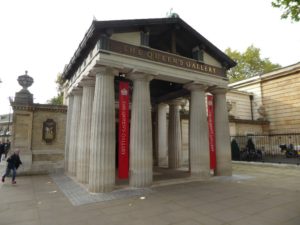 Nowadays the building is 830,000 square feet, has 775 rooms, including 52 royal and guest bedrooms, 188 staff bedrooms, 92 offices and 78 bathrooms, and its beautiful 39-acre garden can be considered the largest private garden in London. Its state rooms, used for official and state entertaining, are open to the public each year for most of August and September and only on some days in winter and spring.
Nowadays the building is 830,000 square feet, has 775 rooms, including 52 royal and guest bedrooms, 188 staff bedrooms, 92 offices and 78 bathrooms, and its beautiful 39-acre garden can be considered the largest private garden in London. Its state rooms, used for official and state entertaining, are open to the public each year for most of August and September and only on some days in winter and spring.
The palace also houses a small public art Gallery, known as the Queen’s Gallery. This Gallery, which was opened to the public in 1962, is located on the site of a private chapel which was destroyed during the second World War under an air raid in 1940. It exhibits works of art from the Royal Collection. The gallery was established to make the Royal Collection more accessible; approximately three art exhibitions are arranged annually. Its collection has been created mainly since the time of Charles II in the mid-17th century. It contains an outstanding collection of oil paintings, watercolors, drawings, and prints, as well as many items of gold, silver, jewelry, furniture, and other decorative art. The extent of the quality of the collection is widely known. They have included shows on individual artists such as Michelangelo, Van Dyck, Hans Holbein the Younger, Canaletto, Thomas Gainsborough, and George Stubbs.
When people visit London, they always feel curious about Buckingham Palace and what it has to offer. The building is not only part of the grounds worth checking out. There are some other appealing places and attractions:
- The Royal garden which is enclosed in its surrounding grounds and occupies 42 acres in the City of Westminster, it includes the famous the Rose Garden (with 25 different varieties, including one created in honor of William called Royal William), a tennis court, and a three-acre lake. Being also known as the Memorial Gardens, the flowerbeds at Buckingham are laid out in a semi-circular design and include some exotic plants as scarlet geraniums, spider plants, and weeping figs. The garden also includes a mulberry tree that dates back to the time of James I of England (1567).
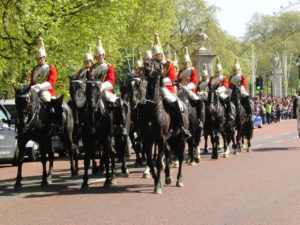
- The Royal Changing of the Guard Ceremony: During this ceremonyin one regiment takes over for another. Per tradition, the New Guard march to Buckingham Palace from Wellington Barracks with musical accompaniment, thereby becoming the Queen’s Guard during the course of the ceremony. Also known as “Guard Mounting,” the tradition takes place at 11 a.m. every other day and daily during the summer.
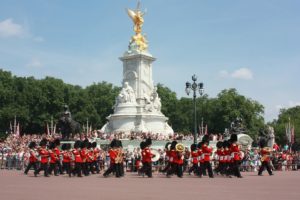 The Victoria Memorial is a sculpture located in the center of the Queen’s Gardens, opposite Buckingham Palace, in London. The sculpture was completed in 1911, being its sculptor Sir Thomas Brock. What surrounds the sculpture was built by Sir Aston Webb, with some 2,300 tons of white marble. The Queen Victoria Memorial has a large statue of Queen Victoria which faces northeast towards The Mall. In the other parts of the monument, there are bronze statues, with the Angel of Justice (facing northwest, Green Park), the Angel of Truth (facing southeast) and Charity facing Buckingham Palace. Queen Victoria is at the top with two seated figures. The filial figures were given away by the people of New Zealand. The entire sculpture has a nautical theme, and this can be seen in the sea mermaids, and the mythological figures related to the sea, which suggest the naval supremacy of the United Kingdom.
The Victoria Memorial is a sculpture located in the center of the Queen’s Gardens, opposite Buckingham Palace, in London. The sculpture was completed in 1911, being its sculptor Sir Thomas Brock. What surrounds the sculpture was built by Sir Aston Webb, with some 2,300 tons of white marble. The Queen Victoria Memorial has a large statue of Queen Victoria which faces northeast towards The Mall. In the other parts of the monument, there are bronze statues, with the Angel of Justice (facing northwest, Green Park), the Angel of Truth (facing southeast) and Charity facing Buckingham Palace. Queen Victoria is at the top with two seated figures. The filial figures were given away by the people of New Zealand. The entire sculpture has a nautical theme, and this can be seen in the sea mermaids, and the mythological figures related to the sea, which suggest the naval supremacy of the United Kingdom.
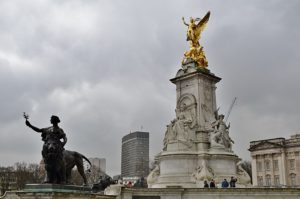 The following links will improve your experience on visiting Buckingham palace, its surroundings, its private interiors and its most captivating attractions:
The following links will improve your experience on visiting Buckingham palace, its surroundings, its private interiors and its most captivating attractions:
BUCKINGHAM PALACE : https://www.youtube.com/watch?v=ApS-QVpwAPM&list=RDCMUCYlW84S3ZOS4RpCmTKBdGow&index=8
https://www.youtube.com/watch?v=ApS-QVpwAPM&list=RDCMUCYlW84S3ZOS4RpCmTKBdGow&index=8
INSIDE BUCKINGHAM PALACE GRAND TOUR: https://www.youtube.com/watch?v=O_fe_b67IqY
https://www.youtube.com/watch?v=O_fe_b67IqY
THE QUEEN’S GARDEN / Garden Party : https://www.youtube.com/watch?v=C3txy5vM8nA
THE CHANGING OF THE GUARD: https://www.youtube.com/watch?v=1wFOIR_uPCw
THE UNVEILING OF THE QUEEN VICTORIA MEMORIAL (1911): https://www.youtube.com/watch?v=R_YUnORqOzU
VICTORIA MEMORIAL AT BUCKINGHAM PALACE: https://www.youtube.com/watch?v=qZewturXN70
QUEEN’S GALLERY: https://www.rct.uk/visit/the-queens-gallery-buckingham-palace
And as a BONUS INFORMATION, what about snooping around other ROYAL RESIDENCES through these two new Links?
LONDON ROYAL RESIDENCES: https://www.youtube.com/watch?v=I6FBsAM8Eek
ROYAL RESIDENCES (WEB) : https://www.royal.uk/royal-art-and-residences
https://www.royal.uk/royal-art-and-residences
EN VALENCIÀ:
Capítol V: Palau de Buckingham i altres residències reials a Londres.
Ara, en aquest cinqué capítol, José Lozano, el formador de #anglés de la #UPBenimàmet t’introdueix en la reialesa; així que el nostre pròxim pas serà visitar el palau de Buckingham i altres residències del Londres monàrquic.
El Palau de Buckingham és la residència londinenca més important de la monarquia del Regne Unit, i no sols es considera com la seua seu administrativa, sinó també com el centre dels esdeveniments d’Estat i de l’hospitalitat real, així com un punt focal per al poble britànic en moments de gaubança i duel nacional.
La terra sobre la qual es troba el Palau de Buckingham, en el barri de Londres conegut com a Westminster, ha estat en mans de la monarquia britànica durant més de 400 anys. Sembla que al Rei James em va agradar l’emplaçament, i el va adquirir per a usar-lo com una espècie de jardí per a la reialesa. També tenia un xicotet bosc de moreres de 4 acres, que el rei James I esperava usar per a la producció de seda (els cucs de seda sol s’alimenten de moreres). En aqueix moment, hi havia una casa en la propietat, i va passar per una successió de propietaris fins a 1698, quan va ser venuda a John *Sheffield, qui més tard es va convertir en duc de Buckingham; i és per això que l’edifici va ser originalment conegut com Buckingham House. Sheffield, en trobar la casa original en la propietat antiquada, va decidir construir una nova residència en el mateix emplaçament a principis de 1700, la qual cosa pot considerar-se com el nucli de l’edifici del palau de hui.
Més tard, aquesta gran casa va ser adquirida pel rei Jorge III en 1761. Va renovar la seua estructura com a residència privada per a la seua esposa, la reina Charlotte i els seus fills. I, després que la seua família es mudara allí, a l’edifici se’l va conéixer com la “Casa de la Reina”.
En 1802, el seu fill Jorge IV, que havia crescut en Buckingham House, va afavorir l’edifici i el va convertir en la residència real oficial. Va contractar als arquitectes John Nash i Edward Blore per a ampliar i renovar l’estructura de l’edifici i van construir tres ales més al voltant d’un pati central. Però quan George IV va morir i el seu germà William IV va ascendir al tron en 1830, no tenia interés a traslladar-se al recentment construït Palacio de Buckingham i va preferir la seua llar principesco, el Palau de Clarence.
En 1833-34, el Parlament britànic va votar per a completar l’equipament i la renovació interior del Palau de Buckingham per al seu ús com a llar real oficial. Després de la mort de Guillem IV, en 1837, la seua neboda, Victoria, va assumir el tron i el Palau de Buckingham es va convertir en la residència de Londres dels monarques britànics fins hui. La seua construcció es va completar en 1853, i la reina Victòria va regnar i va viure allí fins a la seua mort en 1901. El seu fill Eduardo VII va ascendir al tron, i se li atribueix un redissenye interior del palau, les restes del qual encara es poden veure hui.
Les últimes importants addicions estructurals es van realitzar a finalitats del segle XIX i XX; inclòs el Front Aquest, que conté el conegut balcó en el qual la família reial es congrega tradicionalment per a saludar a les multituds. Des de la primera aparició de la Reina Victòria, aparéixer al balcó del palau de Buckingham s’ha convertit en una tradició per als esdeveniments reals. En 2002, la reina Isabel II va saludar a la multitud des del balcó en la celebració del seu jubileu d’or.
Hui dia, l’edifici té 830,000 peus quadrats, té 775 habitacions, incloses 52 habitacions reals i de convidats, 188 habitacions per al personal, 92 oficines i 78 banys, i el seu bell jardí de 39 acres pot considerar-se el jardí privat més gran de Londres. Els seus salons oficials d’Estat, utilitzades per a l’entreteniment oficial i estatal, estan obertes al públic cada any durant la major part d’agost i setembre i solo alguns dies a l’hivern i primavera.
El palau també alberga una xicoteta Galeria pública d’art, coneguda com la Galeria de la Reina. Aquesta galeria, que es va obrir al públic en 1962, es troba en el lloc d’una capella privada que va ser destruïda durant la Segona Guerra Mundial sota un atac aeri en 1940. Exhibeix obres d’art de la Col·lecció Real. La galeria es va establir per a fer més accessible la Col·lecció Real; aproximadament tres exposicions d’art s’organitzen anualment. La seua col·lecció ha sigut creada principalment des de l’època de Carles II a mitjan segle XVII. Conté una excel·lent col·lecció de pintures a l’oli, aquarel·les, dibuixos i gravats, així com molts articles d’or, plata, joies, mobles i altres arts decoratives. L’abast de la qualitat de la col·lecció és àmpliament conegut. Han inclòs exhibicions sobre artistes individuals com Miguel Ángel, Van Dyck, Hans Holbein el jove, Canaletto, Thomas Gainsborough i George Stubbs.
Quan la gent visita Londres, sempre senten curiositat pel Palau de Buckingham i el que ha d’oferir. L’edifici no és només part dels terrenys que valen la pena visitar. Hi ha alguns altres llocs i atraccions atractives:
• El Jardí Reial , que està voltat en els seus terrenys circumdants i ocupa 42 acres de la zona de Westminster, inclou el famós Rose *Garden (amb 25 varietats diferents, incloent una creada en honor de William anomenada Royal William), una pista de tennis, i un llac de tres acres. Sent també coneguts com a Memorial Gardens, els parterres de flors en *Buckingham es presenten en un disseny semicircular i inclouen algunes plantes exòtiques com a geranis escarlates, plantes d’aranya i figueres. El jardí també inclou un arbre de morera que es remunta a l’època de James I d’Anglaterra (1567).
• La Cerimònia de Canvi Real de la Guàrdia: Durant aquesta cerimònia un regiment relleva a l’altre. Per tradició, la Nova Guàrdia marxa al Palau de Buckingham des de Wellington *Barracks amb acompanyament musical, convertint-se així en la Guàrdia de la Reina durant el curs de la cerimònia. També coneguda com “la Guàrdia Muntada”, la tradició té lloc a les 11 a. m. cada dos dies i tots els dies durant l’estiu.
• El Victoria Memorial és una escultura situada en el centre dels Jardins de la Reina, enfront del Palau de Buckingham, a Londres. L’escultura es va completar en 1911, sent el seu escultor Sir Thomas Brock. El que envolta l’escultura va ser construïda per Sir Aston Webb, amb unes 2.300 tones de marbre blanc. El Queen Victoria Memorial té una gran estàtua de la Reina Victòria que mira cap al nord-est cap a The Mall. En les altres parts del monument, hi ha estàtues de bronze, amb l’Àngel de la Justícia (cap al nord-oest, Green Park), l’Àngel de la Veritat (cap al sud-est) i la Caritat enfront del Palau de Buckingham. La reina Victòria està en el cim amb dues figures assegudes. Les figures filials van ser regalades per la gent de Nova Zelanda. Tota l’escultura té un tema nàutic, i això es pot veure en les sirenes de la mar i les figures mitològiques relacionades amb la mar, la qual cosa suggereix la supremacia naval del Regne Unit.
Els següents enllaços milloraran la teua experiència en visitar el palau de Buckingham, els seus voltants, els seus interiors privats i les seues atraccions més captivadores:
BUCKINGHAM PALACE :
https://www.youtube.com/watch?v=ApS-QVpwAPM&list=RDCMUCYlW84S3ZOS4RpCmTKBdGow&index=8
INSIDE BUCKINGHAM PALACE GRAND TOUR:
https://www.youtube.com/watch?v=O_fe_b67IqY
THE QUEEN’S GARDEN / Garden Party :
https://www.youtube.com/watch?v=C3txy5vM8nA
THE CHANGING OF THE GUARD:
https://www.youtube.com/watch?v=1wFOIR_uPCw
THE UNVEILING OF THE QUEEN VICTORIA MEMORIAL (1911):
https://www.youtube.com/watch?v=R_YUnORqOzU
VICTORIA MEMORIAL AT BUCKINGHAM PALACE:
https://www.youtube.com/watch?v=qZewturXN70
QUEEN’S GALLERY:
https://www.rct.uk/visit/the-queens-gallery-buckingham-palace
I com a INFORMACIÓ ADDICIONAL, què tal si tafanegem en altres RESIDÈNCIES REIALS a través d’aquests dos nous Enllaços?
LONDON ROYAL RESIDENCES:
https://www.youtube.com/watch?v=I6FBsAM8Eek
ROYAL RESIDENCES (WEB)
https://www.royal.uk/royal-art-and-residences
INDICACIONS:
Els participants podran visualitzar i rebre informació amb certa periodicitat a través de determinats links de vídeos i pàgines d’internet alguns dels llocs més emblemàtics de la capital del Regne Unit; de tal forma que puguen ser difós i compartits entre els participants prenent el link de la web www.universitatpopular.com/upacasa amb l’etiqueta #stayathomeandvisitlondon en les seues xarxes socials.
Amb quins materials?:
Connexió a Internet i aplicació Youtube
Quin objectiu persegueix la proposta:
- Mantindre el contacte amb la comunitat de la UP
- Dinamitzar als grups d’activitat d’Inglés i qualsevol persona que accedint a la web UP puga simpatitzar tant amb el projecte general de la Universitat popular com amb els continguts impartits en l’activitat.
- Involucrar a les participants en un projecte global de UP més enllà de la pertinença a un centre concret
- Respondre als objectius de la programació del la activitat d’anglés del present curs.
- Combatre les dificultats que presenta el confinament, especialment respecte a la soledat i aïllament per mitjà d’una activitat lúdica.
